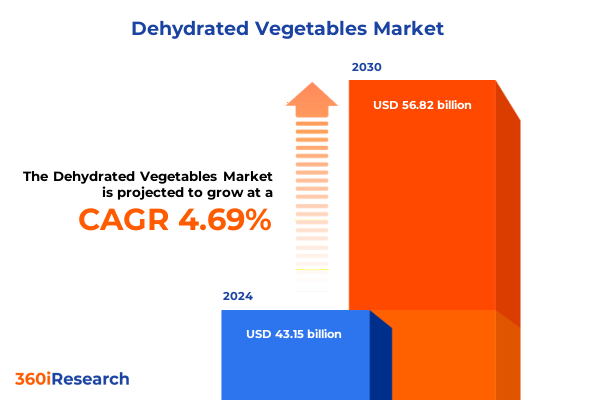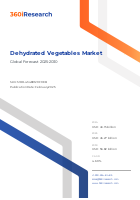The Dehydrated Vegetables Market size was estimated at USD 43.15 billion in 2024 and expected to reach USD 45.27 billion in 2025, at a CAGR 4.69% to reach USD 56.82 billion by 2030.

Introduction to the Key Dynamics of the Dehydrated Vegetables Market
Dehydrated vegetables have steadily emerged as a vital segment within the broader food landscape, driven by changing consumer habits, nutritional awareness, and the demand for convenience. This report examines the market with a keen focus on the evolution of processing methods, rising trends in health and wellness, and the economic factors that underpin the industry's growth. The insights presented here meticulously explore various facets of production, technological innovations, and distribution strategies. With robust analytical techniques and deep market knowledge, this analysis offers an in-depth look into the landscape that supports innovation at every stage of the value chain. The market is witnessing an era defined by both traditional drying methods and surprisingly novel techniques that effectively balance cost, shelf life, and product quality. Stakeholders looking to invest or further expand in this domain will find that the market is as much about competitive differentiation as it is about meeting diverse consumer expectations in an increasingly saturated marketplace. Overall, this introduction sets the stage for a detailed narrative that captures the multifaceted dynamics of the dehydrated vegetables industry.
Transformative Shifts in the Dehydrated Vegetables Landscape
Recent years have seen transformative shifts in the production and consumption of dehydrated vegetables, with technological breakthroughs revolutionizing conventional practices. Market participants have been quick to adopt advanced methods that not only enhance quality but also improve cost efficiency by reducing waste and energy consumption. Process innovation is at the forefront of these changes, evident in the adoption of modern drying techniques that are significantly different from traditional methods. Cultural trends geared towards sustainability and healthier food choices are further driving transformation within the supply chain. Increasingly sophisticated processes, heightened automation, and the integration of digital monitoring systems have contributed to a more reliable and consistent product offering, satisfying both artisanal demands and mass market criteria. The marketplace has become more agile, which is reflected in a rapid response to fluctuations in demand and the adaptation of flexible production models. As conventional packaging and distribution channels are reimagined, it becomes evident that the industry’s evolution represents not only a technological leap but also a strategic repositioning in response to consumer and regulatory pressures.
Key Segmentation Insights in the Dehydrated Vegetables Market
A comprehensive analysis of market segmentation reveals the intricate layers that underpin the dehydrated vegetables market. A study based on product type encompasses an array of drying techniques such as air-dried, freeze-dried, spray-dried, and vacuum-dried methods. In-depth evaluations indicate that within air-dried products, variations like oven-dried and sun-dried represent essential sub-categories, while within vacuum-dried products, the specialized microwave-vacuum drying process is gaining traction. In addition, the segmentation according to vegetable type offers insights into categories as diverse as edible stems, flower vegetables, fruiting vegetables, leafy vegetables, and root vegetables. Such segmentation provides clarity on consumer preferences and guides manufacturers toward tailoring their production processes. Packaging decisions also play a strategic role with variations that include bulk packaging—with further nuance through industrial packing—and disposable, flexible, and rigid packaging solutions. Application-based segmentation reveals demand channels in ready meals, salads, snacking, and soups and stews, where ready meals are dissected into heat-and-eat meals and instant noodle additives, and snacking extends to on-the-go options. Moreover, distribution channels, ranging from convenience stores and online retail to specialty food stores and supermarkets paired with hypermarkets, align with distinct market expectations. When examining segmentation through the lens of end-user dynamics, it is evident that catering services, incorporating event catering, hotels and restaurants with a fine dining focus, households, and processed food manufacturers, including instant meal producers, drive targeted innovation across the value chain.
This comprehensive research report categorizes the Dehydrated Vegetables market into clearly defined segments, providing a detailed analysis of emerging trends and precise revenue forecasts to support strategic decision-making.
- Product Type
- Vegetable Type
- Packaging Type
- Application
- Distribution Channel
- End Users
Key Regional Insights of the Dehydrated Vegetables Market
An evaluation of regional variations offers a nuanced understanding of the market's global footprint. In the expansive terrain of the Americas, innovations have been supported by a strong network of supply chains and consumer demand for healthier convenience foods. The region's robust economic indicators and favorable regulatory environment have created an ecosystem that encourages both small-scale producers and large industrial players to experiment with novel dehydration technologies. In contrast, the intervening markets in Europe, Middle East & Africa are characterized by varying levels of market maturity, where legacy processing techniques blend with emerging innovations. Regions in these areas have shown a consistent preference for sustainable practices and innovative packaging solutions that extend shelf life while preserving nutritional content. The Asia-Pacific market represents a dynamic convergence of traditional culinary practices and modern food processing innovations. Rapid urbanization, shifting demographics, and increasing disposable incomes have significantly boosted demand in this region. Together, these regions collectively paint a picture of an industry that is resilient, multi-faceted, and primed for continued growth. The insights underscore how geographic diversity influences both consumer behavior and the adoption of advanced processing technologies, setting the stage for tailored strategies in market expansion.
This comprehensive research report examines key regions that drive the evolution of the Dehydrated Vegetables market, offering deep insights into regional trends, growth factors, and industry developments that are influencing market performance.
- Americas
- Asia-Pacific
- Europe, Middle East & Africa
Insights on Leading Companies in the Dehydrated Vegetables Sector
Market leadership in the dehydrated vegetables sector is underscored by the strategic initiatives and product innovations implemented by several prominent companies. Entities such as Baobab Foods LLC and Batory Foods have established robust channels that directly address contemporary consumer demands. Other regional and international players like BCFoods Europe B.V., Catz International B.V., and FutureCeuticals have distinguished themselves by adopting cutting-edge technologies designed to optimize both production and quality assurance. More specialized companies including Jaworski and Kanegrade Ltd. are prioritizing efficiency improvements, while Mevive International and Rabeler Fruchtchips GmbH have tailored their portfolios to cater to niche market segments. This list is further complemented by Innovators such as Real Dehydrates Pvt. Ltd. and ROHA Dyechem Pvt. Ltd., who are forging new standards in product consistency and safety. Silva International, along with Van Drunen Farms and Vitachem s.r.o., continues to expand its market footprint through strategic partnerships and quality certification, setting benchmarks for the industry. Additionally, companies like W. Kündig & Cie AG are leveraging technological advancements to drive sustainability and reduce operational costs. Combined, these companies offer an illustrative view of the diverse strategies being employed to secure market share and foster innovation within the industry.
This comprehensive research report delivers an in-depth overview of the principal market players in the Dehydrated Vegetables market, evaluating their market share, strategic initiatives, and competitive positioning to illuminate the factors shaping the competitive landscape.
- Baobab Foods LLC
- Batory Foods
- BCFoods Europe B.V.
- Catz International B.V.
- FutureCeuticals
- Jaworski
- Kanegrade Ltd.
- Mevive International
- Rabeler Fruchtchips GmbH
- Real Dehydrates Pvt. Ltd.
- ROHA Dyechem Pvt. Ltd.
- Silva International
- Van Drunen Farms
- Vitachem s.r.o.
- W. Kündig & Cie AG
Actionable Recommendations for Industry Leaders in the Dehydrated Vegetables Market
In light of evolving consumer preferences and technological advancements, industry leaders are advised to adopt a multifaceted strategy to secure competitive advantage. Firstly, invest in research and development initiatives that focus on optimizing dehydration technologies. This includes exploring novel drying techniques that not only reduce energy consumption but also enhance product quality. Secondly, leverage data-driven decision making to streamline supply chain operations while accommodating fluctuations in global demand. Integrated digital tools and smart packaging innovations can significantly reduce logistic inefficiencies and contribute to sustainability goals. Thirdly, consider expanding product offerings by catering to niche consumer segments that seek specialized preparation methods and innovative flavors. Precision in packaging—from disposable to flexible and rigid formats—can be a defining factor in market differentiation. Additionally, diversifying distribution channels remains critical; while traditional retail structures continue to hold relevance, investments in online retail platforms can unlock new opportunities. Furthermore, forging strategic alliances with regional stakeholders could allow companies to access emerging markets with distinct consumer behaviors. Lastly, maintain agility in regulatory compliance by closely monitoring shifts in food safety standards and environmental policies. Such a proactive approach will not only enhance brand credibility but also fortify long-term growth prospects.
Explore AI-driven insights for the Dehydrated Vegetables market with ResearchAI on our online platform, providing deeper, data-backed market analysis.
Ask ResearchAI anything
World's First Innovative Al for Market Research
Conclusion of the Executive Summary
The analysis of the dehydrated vegetables market clearly demonstrates an industry in transition, shaped by both technological innovation and shifting consumer priorities. The convergence of traditional drying methods with groundbreaking processing techniques has produced an ecosystem where efficiency and quality are paramount. Detailed segmentation offers an illuminating perspective on the diverse product lines, packaging options, and application channels that drive the market forward. Furthermore, regional insights provide clarity on how geographical variations influence production and consumption trends, while the proactive strategies adopted by leading companies set a benchmark in operational excellence and product integrity. The insights and recommendations detailed herein emphasize the need for industry players to remain agile, invest in emerging technologies, and tailor their approaches to accommodate the evolving market spectrum. Through strategic planning and innovative initiatives, stakeholders can seize the opportunities that lie within this vibrant market, ensuring sustainable growth and a competitive edge in a dynamic global landscape.
This section provides a structured overview of the report, outlining key chapters and topics covered for easy reference in our Dehydrated Vegetables market comprehensive research report.
- Preface
- Research Methodology
- Executive Summary
- Market Overview
- Market Insights
- Cumulative Impact of United States Tariffs 2025
- Dehydrated Vegetables Market, by Product Type
- Dehydrated Vegetables Market, by Vegetable Type
- Dehydrated Vegetables Market, by Packaging Type
- Dehydrated Vegetables Market, by Application
- Dehydrated Vegetables Market, by Distribution Channel
- Dehydrated Vegetables Market, by End Users
- Americas Dehydrated Vegetables Market
- Asia-Pacific Dehydrated Vegetables Market
- Europe, Middle East & Africa Dehydrated Vegetables Market
- Competitive Landscape
- ResearchAI
- ResearchStatistics
- ResearchContacts
- ResearchArticles
- Appendix
- List of Figures [Total: 28]
- List of Tables [Total: 634 ]
Call to Action for Report Purchase with Ketan Rohom
For decision-makers ready to elevate their understanding of this dynamic market landscape, now is the ideal time to act. The comprehensive report encapsulates all essential aspects of the dehydrated vegetables market—from transformative technologies and segmentation nuances to regional and company-specific insights. By investing in this report, you access invaluable data that supports strategic planning and competitive positioning. To secure a copy or discuss the findings in further detail, reach out directly to Ketan Rohom, Associate Director, Sales & Marketing. Engage proactively to gain the intelligence necessary for navigating future opportunities and challenges in the market.

- How big is the Dehydrated Vegetables Market?
- What is the Dehydrated Vegetables Market growth?
- When do I get the report?
- In what format does this report get delivered to me?
- How long has 360iResearch been around?
- What if I have a question about your reports?
- Can I share this report with my team?
- Can I use your research in my presentation?




